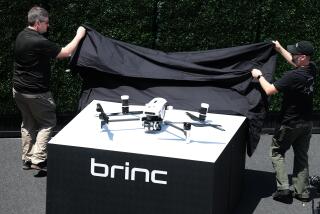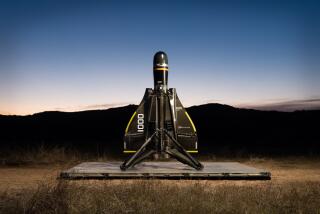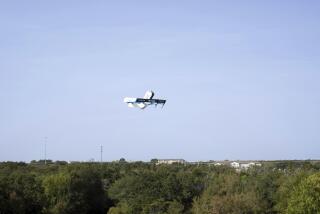Amazon patents delivery drones that can react to people screaming and flailing

Amazon hopes someday to speedily deliver packages to customers by using aerial drones.
Amazon.com Inc. has been granted a new patent by the U.S. Patent and Trademark Office for a delivery drone that can respond to human gestures.
The concept is part of Amazon’s goal to develop a fleet of unmanned aerial vehicles that can send packages to customers in 30 minutes or less. Issued this week, the patent may help Amazon grapple with how flying robots might interact with human bystanders and customers waiting on their doorsteps.
Depending on a person’s gestures — a welcoming thumbs-up, shouting or frantic arm waving — the drone can adjust its behavior, according to the patent. As described in the patent, the machine could release the package it’s carrying, change its flight path to avoid crashing, ask humans a question or abort the delivery.
Among several illustrations in the design, a person is shown outside a home, flapping his arms in what Amazon describes as an “unwelcoming manner,” to showcase an example of someone shooing away a drone flying overhead. A voice bubble comes out of the man’s mouth, depicting possible voice commands to the incoming machine.
“The human recipient and/or the other humans can communicate with the vehicle using human gestures to aid the vehicle along its path to the delivery location,” Amazon’s patent states. (Amazon Chief Executive Jeff Bezos owns the Washington Post.)
Another diagram depicts the steps a drone would take when reading human body language as it delivers packages: “Receive human gesture”; “access gesture database”; “determine human gesture based on gesture database”; “proceed in accordance with determined human gesture and delivery instructions.”
According to the patent, the drone’s communication system would include an array of sensors, including a depth sensor and cameras to detect visible, infrared and ultraviolet light. The drones would be able to recognize hand and body gestures, human voices and movement, such as a person walking closer to the drone or away from it.
If the drones are cleared to deliver, they can release boxes with extra padding from the air, or they can land and then offer the parcels, the patent said.
Since unveiling its plans to develop an air delivery service, Amazon has applied for several ambitious patents that include the use of giant airships to serve as mobile, flying warehouses, and designs for drones that self destruct during an emergency.
There’s no word on when or even whether the gesture-recognition system might debut. Amazon declined to comment. In 2016, the company made its first autonomous drone delivery to a shopper in the United Kingdom. A private customer trial for drone delivery in Britain is ongoing.






